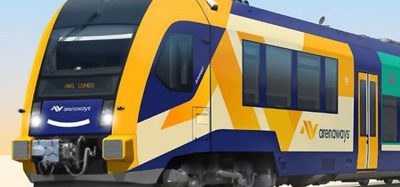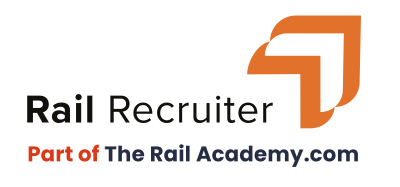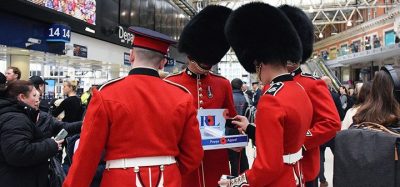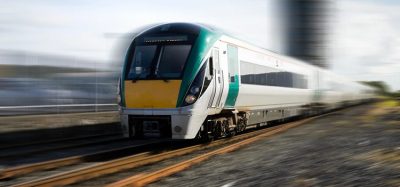Amtrak celebrates a successful 2021 fiscal year and COVID-19 recovery
Posted: 14 December 2021 | Global Railway Review | No comments yet
Amtrak’s 2021 fiscal year highlights the company’s successful COVID-19 recovery, with ridership and revenue growth, and the introduction of new projects and initiatives for the future.
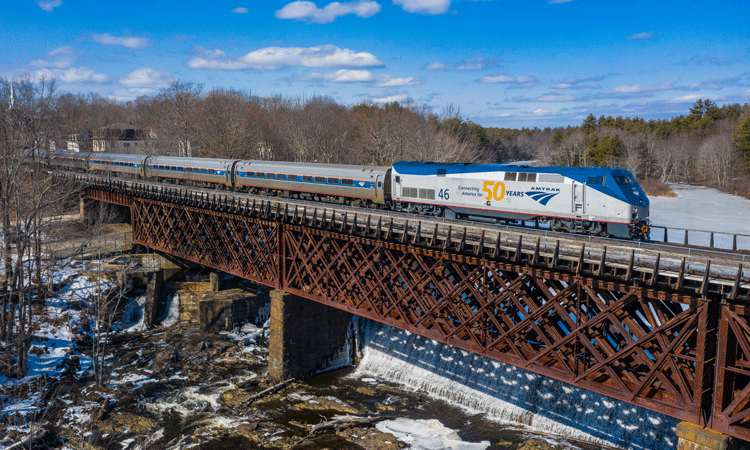

Credit: Amtrak
Amtrak successfully advanced its COVID-19 recovery efforts throughout its 50th Anniversary fiscal year, through continued safety measures for customers and employees, increased train service levels in line with growing demand, and continued building a strong foundation for modernisation and growth. With announcements of its largest order for new trains in decades, the opening of new stations, the addition of new customer services and amenities, and Amtrak’s proposals for new corridor service in up to 160 communities, Amtrak put in motion key initiatives to support an enhanced national rail network capable of serving more people in more places with better service.
“Our customers trust Amtrak’s commitment to safety and are responding positively to the investments and improvements we are making,” said Amtrak CEO, Bill Flynn. “We will continue to prioritise offering a modern, safe, and reliable customer experience and preparing for what should be a monumental fiscal year 2022.”
Business is now at about 70 per cent of pre-COVID-19 levels, up from 25 per cent at this time in FY20, and based on the current forecast, ridership and revenue is expected to improve to about 80 per cent of pre-COVID-19 levels by the end of fiscal year 2022.
Amtrak Board Chair, Tony Coscia said: “Our 50th year as a company is certainly a milestone, and we launched several hallmark initiatives as we embark on a new era for passenger rail. The Bipartisan Infrastructure Law enacted by the Biden Administration and Congress is a historic investment that will benefit customers and communities and prove that Amtrak is an important part of a larger solution to help America tackle the climate crisis, create economic opportunity, and expand mobility.”
Preliminary results for fiscal year 2021 (October 2020 to September 2021) include:
- Safety: Since the COVID-19 vaccine offers the best way to keep its employees and customers safe, Amtrak required employees to become vaccinated, resulting in 97 per cent of Amtrak’s employees with at least one vaccination dose, excluding employees who are on leave of absence or have an approved accommodation.
- Total capital spend: Advanced $2.2 billion in capital spending, including major milestones such as the Hudson Tunnel Project property acquisition and new multi-powered trainsets.
- Ridership: Provided 12.2 million customer trips, with more than half of those trips taking place in the second half of the year, and growth of four million over the 2020 rate and a 42 per cent increase over its FY21 goal.
- Adjusted operating earnings: $1.08 billion and $400 million ahead of plan due to strong ridership gains driven by new approaches to marketing and pricing that helped attract new riders.
Amtrak highlights in fiscal year 2021 include:
Amtrak Connects Us
…the Corridor Vision builds upon Amtrak’s national network, integrating new and improved corridors to expand the existing system.
Amtrak launched the company’s vision to advance the development of more frequent, reliable and sustainable intercity passenger rail service to over 160 more communities and 20 million more passengers annually by 2035, as outlined in the Amtrak Corridor Vision. To be implemented in collaboration with states, local communities, the administration and many other stakeholders, the Corridor Vision builds upon Amtrak’s national network, integrating new and improved corridors to expand the existing system. The economic benefit of Amtrak’s Corridor Vision could reach $8 billion annually by 2035, with an additional $195 billion in economic activity generated by additional capital investment between 2021 and 2035. More than 26,000 ongoing permanent jobs plus 616,000 person-years of employment supported by capital investments could also be created or supported by this vision during this time.
New service
After more than five years of data-driven and federally led studies, Amtrak initiated a process before the U.S. Surface Transportation Board to require CSX Transportation and Norfolk Southern Railway to permit the operation of two daily Amtrak trains between New Orleans and Mobile. Amtrak has a legal right to use this route, which has sufficient capacity to host these trains, and there is up to $66 million in funds from federal and state sources to support necessary improvements for the new intercity passenger rail service. These potential investments have been reviewed, approved, and funded by the Federal Railroad Administration (FRA), Amtrak and others. Amtrak also executed a historic $944 million agreement with Virginia to more than double the number of state-sponsored services in the Commonwealth during the next 10 years.
Equipment
A contract was announced with Siemens Mobility Inc. to manufacture a new fleet of up to 83 multi-powered modern trains…
A contract was announced with Siemens Mobility Inc. to manufacture a new fleet of up to 83 multi-powered modern trains that will be leveraged for state and Northeast services, with further options for up to 130 additional trains to support Amtrak growth plans. Most of these trainsets will provide both electric and diesel power, as well as some with cutting-edge battery power, to create a common platform for use across Amtrak’s various routes and modern rail amenities to better serve all Amtrak customers. These new trains will operate on the Northeast Corridor (NEC), Palmettoand various state-supported routes and will replace the current Amfleet I, Metroliner cab and Cascades service fleets. Amtrak also continued to advance production of the new Acela trainsets that will transform travel on the NEC and ALC-42 diesel-electric locomotives that will power the National Network.
Stations
Amtrak expanded its footprint and significantly upgraded the customer experience in New York City with the opening of Moynihan Train Hall.
Amtrak expanded its footprint and significantly upgraded the customer experience in New York City with the opening of Moynihan Train Hall. At New York Penn Station, Amtrak installed new wayfinding signage and an Ultraviolet Germicidal Irradiation System in one of the Heating, Ventilation and Air-Conditioning units in the Amtrak concourse, refreshed platforms and completed the second and final phase of the Ticketed Waiting Area refresh in conjunction with NJ TRANSIT. Amtrak also achieved financial close with Plenary Infrastructure Philadelphia (PIP) on a lease and development agreement for the restoration and renovation of the William H. Gray III 30th Street Station in Philadelphia. Under the agreement, PIP will refurbish and improve the historic building, finance those improvements and maintain the station for a 50-year term. Announced with the State of Vermont, the Town of Brattleboro, and NECR Railroad a proposal for a new Americans with Disabilities Act (ADA)-compliant Brattleboro Station.
Infrastructure
Amtrak unveiled new plans to enhance and advance the Baltimore & Potomac Tunnel Replacement Programme together with the Maryland Department of Transportation. Amtrak broke ground on the Baltimore Penn Station redevelopment and platform improvements. To allow for greater operability of train service, Amtrak is rebuilding a low-level platform into an ADA-compliant high-level platform. This work, along with a renewed overhead electrical system and an upgraded 30-mile stretch of track between Baltimore Penn Station and Washington Union Station, will enable higher speed operations. Once fully completed, these upgrades will improve on-time performance for high-speed train operations by providing route flexibility and allowing unimpeded travel.
Gateway
The Hudson Tunnel Project secured all necessary federal environmental approvals and permits, including the Final Environmental Impact Statement (EIS) and Record of Decision (ROD) from the FRA and Federal Transit Administration (FTA) and the Section 404/10 permit from the U.S. Army Corps of Engineers for construction within the New Jersey Meadowlands and Hudson River. Completion of the EIS and issuance of a ROD by the FRA and FTA is a major milestone for the project, permitting the Hudson Tunnel Project to qualify for FTA’s Capital Investment Grants Programme, based on a new financial plan submitted by the Gateway Programme project partners. The FEIS/ROD also allowed Amtrak to purchase a critical property in Manhattan, 260 12th Avenue, the site of the construction shaft and permanent ventilation plant for the tunnel. Also in 2021, the Portal North Bridge Project secured a Full Funding Grant Agreement from the FTA and NJ TRANSIT approved the award of the construction contract for the project, positioning the Bridge project to commence construction in early 2022.
Product upgrades
Amtrak launched and expanded several popular programmes to provide customers with improved amenities.
Amtrak launched and expanded several popular programmes to provide customers with improved amenities. This included the debut of a refreshed food and beverage menu along with top-quality dining experience for customers riding in First Class on-board Acela. Amtrak also restored and reimagined traditional dining service on the California Zephyr, Coast Starlight, Empire Builder, Southwest Chief, Sunset Limited, and Texas Eagle following pandemic-related suspension of the service. In addition, Amtrak initiated a multi-million-dollar and multi-year project aimed to improve the customer experience aboard long-distance trains by refreshing over 450 railcar interiors. With an expanded carry-on bike programme for state-sponsored trains operating in Virginia, customers can now store their bike in the passenger coach in a designated space. Customers can also take advantage of a relaunched USA Rail Pass for a new and affordable way to take a multi-segment train journey. Additionally, Amtrak achieved record ticket revenue by the Auto Train following an expansion of private room capacity and development of new pricing and marketing tactics to promote this unique service. Lastly, Amtrak debuted its BidUpSM programme, offering upgrades to Business Class, First Class and private rooms, expanded the pet programme, and introduced private rooms on select Northeast Regional trains.
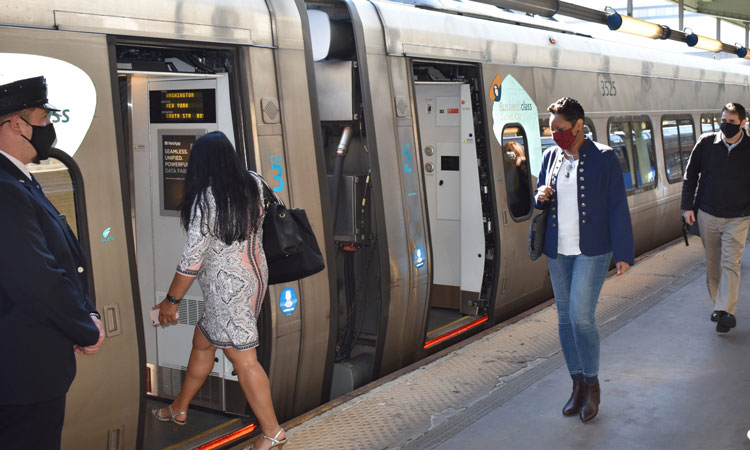

In April 2021, U.S. Secretary of Transportation announced $1.69 billion COVID-19 relief funding for Amtrak. Credit: Amtrak
Sustainability
Amtrak announced a contract for up to 83 multi-powered trains, and received the delivery of the first new ALC-42, that will lead to reduced greenhouse gas emissions. All passengers travelling on the NEC, between Boston and Washington, D.C., are now provided their trip-specific carbon emissions savings. Savings achieved by taking Amtrak are shown as how much riders saved by not driving and flying. On the NEC, travel with Amtrak produces 83 per cent less emissions than driving alone and up to 73 per cent less than flying.
Climate resilience
…Amtrak created a resilience strategic plan to integrate climate considerations into business practices and planning efforts.
Amtrak developed and is implementing a Climate Resiliency Strategic plan, including a climate vulnerability assessment for the NEC, and establishing a path for long-term substantial reductions in greenhouse gas emissions across the company’s operations. The climate vulnerability assessment will identify assets and segments of the electrified rail network where heat, sea level rise, wind, and heavy precipitation events could notably affect the Amtrak business by mid-century and 2100. Along with the vulnerability assessment, Amtrak created a resilience strategic plan to integrate climate considerations into business practices and planning efforts.
Planning
Despite COVID-19 challenges, Amtrak collaborated with more than 3,500 individuals across the country through training, exercises and emergency response planning. Working with multiple Federal agencies including the FRA, FBI, FEMA, and NTSB, trainings informed and improved Amtrak’s ability to respond to and recover from emergency incidents.
Safety
Positive Train Control (PTC) was successfully activated on all required routes across the Amtrak system in advance of new regulations.
Positive Train Control (PTC) was successfully activated on all required routes across the Amtrak system in advance of new regulations. There has been increased Amtrak Police Department presence in stations and on-board trains to help enforce the federal transportation mask mandate. Nearly 500 Police and Sheriff’s departments across 43 states and the District of Columbia joined the Amtrak Police Department and Operation Lifesaver Inc. to conduct ‘Operation Clear Track,’ the single largest railroad safety law enforcement detail in the U.S. Amtrak also trained 3,052 employees in Safety Starts with Me, an internal safety programme.
Vaccine Mandate
In August 2021, Amtrak issued a mandate requiring that all employees be fully vaccinated against COVID-19. To support this mandate, Amtrak provided on-site vaccine clinics, was among the first companies to introduce a compensation allowance for employees who provided proof they had been vaccinated and provided compensation for time off due to vaccine recovery. Amtrak also held town halls devoted to providing information about the vaccines explained by Amtrak’s medical director and established the first business-to-business relationship with a national pharmacy to ensure vaccine access. Amtrak co-ordinated 48 COVID-19 vaccine clinics across the country for Amtrak employees and their families resulting in an employee vaccination rate well ahead of many major businesses.
Accessibility
In FY21, more than 1,000 employees completed Amtrak’s enhanced accessibility training…
Progressing work at 95 stations, Amtrak expended over $93 million on ADA station projects; this includes five assessments, 28 station designs, 20 station construction projects, 16 Passenger Information Display System (PIDS) designs, and three PIDS deployments. Amtrak also continued its aggressive approach to making stations accessible by having 155 stations fully or partially ADA-compliant. Aiming to expand accessibility to passengers across all fleets, Amtrak continued efforts on the ADA Fleet Compliance project, which comprises 12 separate rail car modifications, such as installing onboard wheelchairs for quick evacuation, applying non-skid vestibule floor coating, and modifying the first floor of bi-level Long Distance cars to create an accessible path of travel to ADA compliant restrooms. In FY21, more than 1,000 employees completed Amtrak’s enhanced accessibility training, ensuring that customer-facing employees receive intensive eight-hour, in-person training. Despite impacts due to the COVID-19 pandemic, Amtrak still hosted 130 accessibility classes across 19 U.S. cities.
Technology
Amtrak began offering new digital payment options on its mobile app and website…
Amtrak began offering new digital payment options on its mobile app and website, and introduced app improvements, including the expansion of push notification capabilities for gate and track information, new notification offerings featuring tips and information during service disruptions or cancellations, a text service to speak directly to an agent and the ability to cancel (initiate a refund) or modify a trip. Amtrak has also introduced digital timetables that provide customers with real-time schedule information for a given city pair.
State-supported services
Amtrak launched an expanded rail service from Richmond to the Northeast Corridor and an additional nearly $1 billion Amtrak investment in the $3.7 billion in the Commonwealth of Virginia’s Transforming Rail in Virginia programme to expand and improve passenger, commuter, and rail freight in Virginia and create a vital connection in America’s national rail network between the Northeast and Southeast corridors.
Diversity and inclusion
Amtrak implemented initiatives to improve diversity, inclusion and belonging for Amtrak employees.
Amtrak implemented initiatives to improve diversity, inclusion and belonging for Amtrak employees. Amtrak increased targeted recruiting efforts, launched seven Employee Resource Groups to support its diverse workforce and achieved a 9.2 per cent increase in women hired. The company established Juneteenth as a holiday for all employees, and established four scholarships to support minority students attaining higher education or a college degree, or a woman pursuing a STEM degree.
Talent and people
Amtrak extended 1,744 employment offers and scaled up recruitment, hiring and retention efforts. In addition, Amtrak supported company-wide COVID-19 response and remote working efforts including developing a process for accommodation requests. Amtrak invested in talent and advanced technology through Market Competitive Benefits with offerings to managers that are more simple, personal, relevant, and competitive. Amtrak also defended its new Drug & Alcohol-Free Workplace Policy successfully in arbitration and recalled more than 1,200 furloughed employees after receiving COVID-19 relief funding.
Leadership
Amtrak named Laura Mason as Executive Vice President of Major Programme Delivery to lead a new organisation responsible for delivering Amtrak’s largest infrastructure, fleet, and station programmes. Furthermore, Stephen Gardner was appointed President as part of a broader set of actions taken under Bill Flynn’s leadership, working with the Board of Directors, to ensure that Amtrak is well positioned for success.
Related topics
Cargo, Freight & Heavy-Haul, Coronavirus/COVID-19, Digitalisation, Electric/Hybrid Rolling Stock, Funding & Finance, Infrastructure Developments, Passenger Experience/Satisfaction, Passengers With Reduced Mobility (PRM), Rolling Stock Components (Interior/Exterior), Rolling Stock Maintenance, Rolling Stock Orders/Developments, Route Development, Safety, Station Developments, Sustainability/Decarbonisation, Technology & Software, The Workforce




